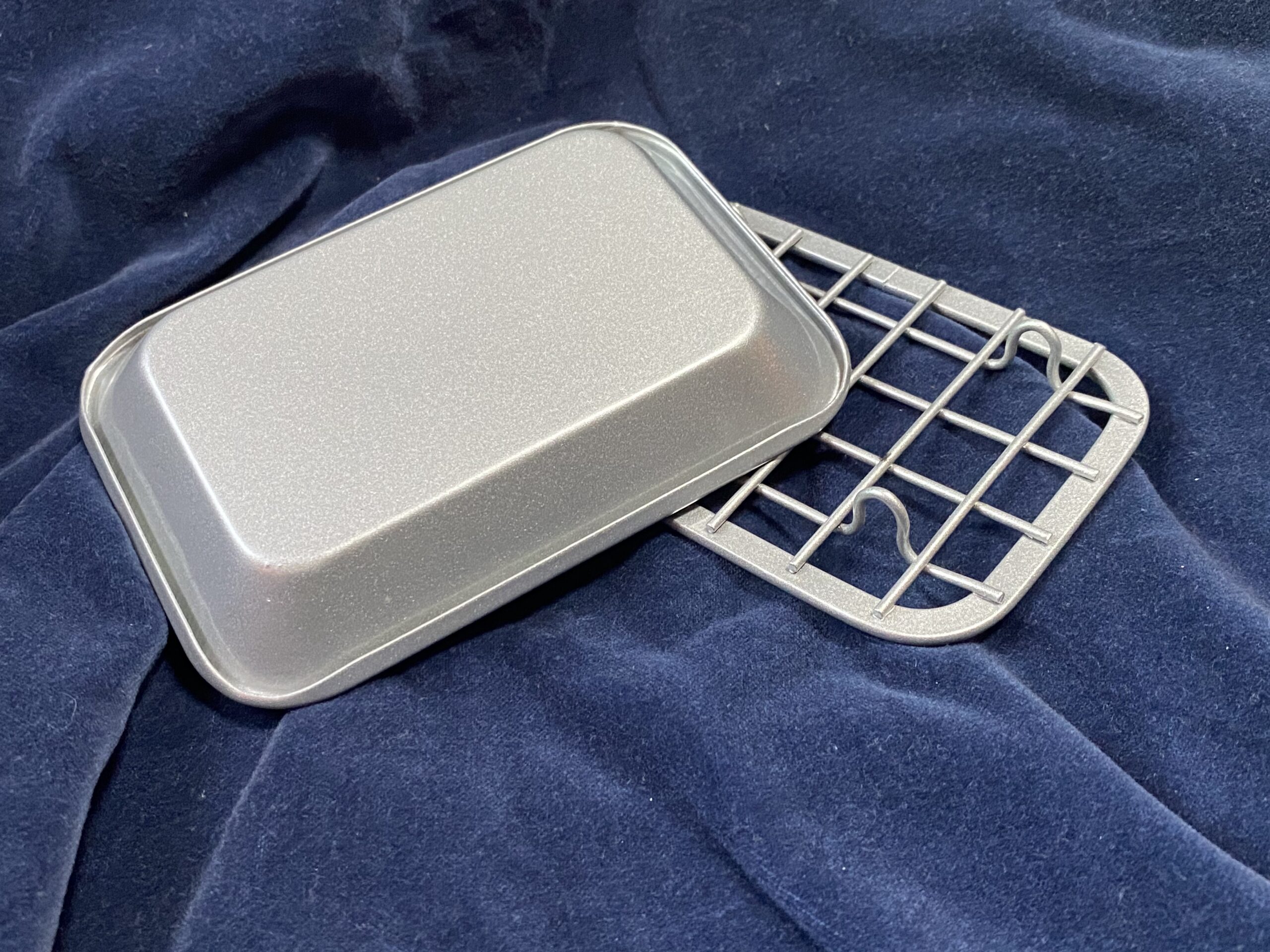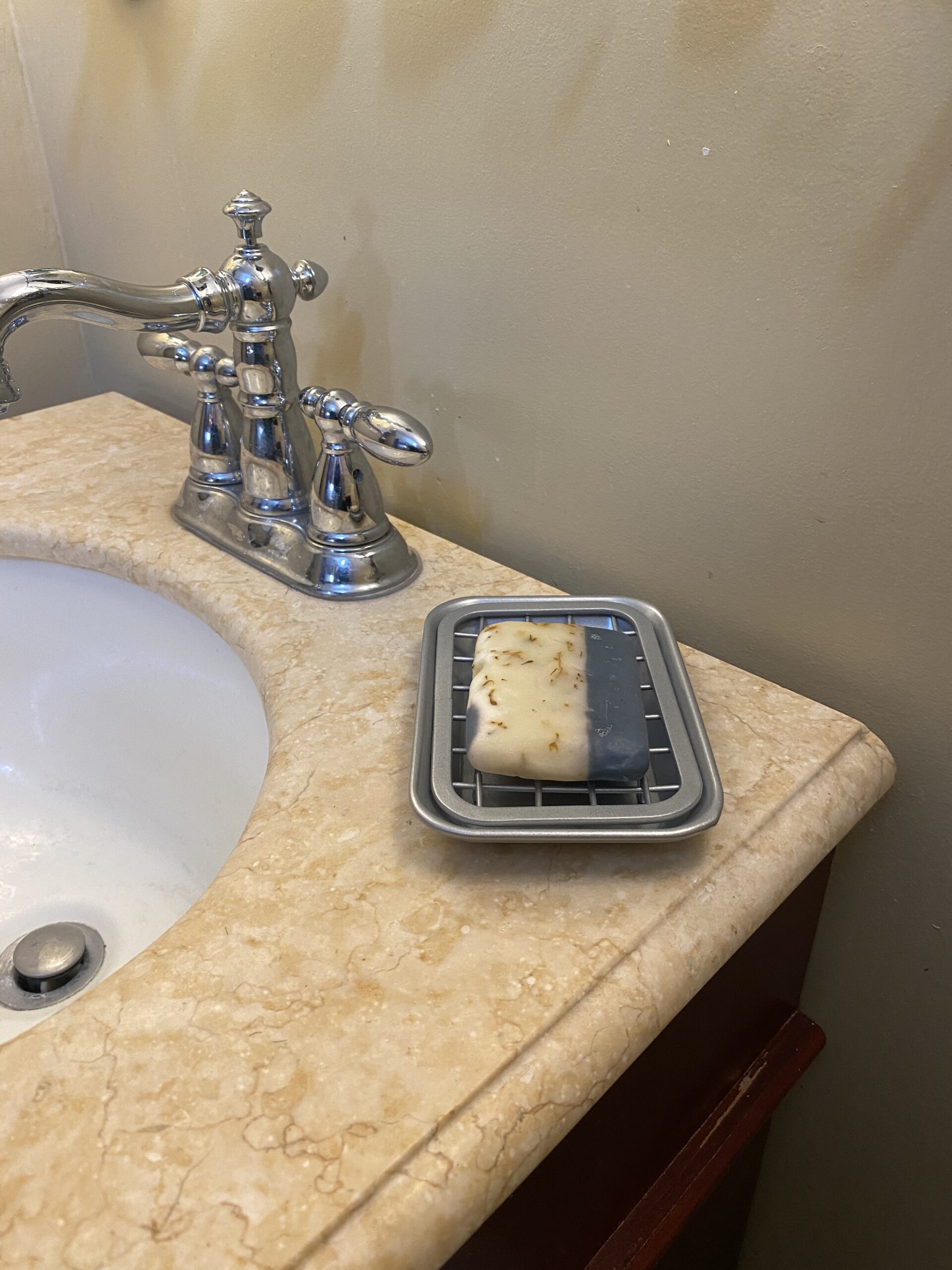Tamara’s Favorite Things: “Stainless Steel” soap dish – I love this style (plus, it is Lead-free! & Cadmium-free! Etc.)


 Tamara’s Favorite Things
Tamara’s Favorite Things
February 22, 2022 – Tuesday
Yet another example showing that “Lead-free” does not mean “expensive”!
We have had one of this style of soap dish in (actual) stainless steel in our shower for years now, and I really love the design and function of it because after the kids shower I can pick up the top part of the tray with the soap bar resting on it and easily dump out the extra water that has collected in the small basin under the soap.
I don’t know where we purchased our first one [I think possibly Target] — and the tray on that one is actually stainless steel (vs. painted steel), but I wanted to get a couple more — because now that we are strictly using soap in bar-form (made by my friend Adriana!) I needed a place to put the soap to dry after use, rather than let it sit in a puddle of water and turn to mush.
I bought these (pictured here – with test results, below) on Amazon, because they looked similar to the one I already had — but when they arrived, I could tell from the slippery feel of the surface (and the “sparkle” in the finish – like tiny glitter) that they are painted (with some sort of powder-coat or non-stick type coating), so even though they looked like stainless in the Amazon images for the product, they were not.
This consideration bore out when it was confirmed with the XRF testing I did for the soap dish in question. [The software on the XRF instrument reports to the user if a Stainless Steel alloy has been detected [AND even what specific alloy/grade of stainless steel is detected]; stainless steel was not recognized by the instrument in this case.] What is stainless steel exactly? Click here to read more about that.
Below are the full XRF readings for the soap dish pictured
Continue reading below the test results
Reading #1) on the edge of the top grate of the dish
30-second reading
- Lead (Pb): non-detect
- Cadmium (Cd): non-detect
- Mercury (Hg): non-detect
- Arsenic (As): non-detect
- Nickel (Ni): non-detect
- Antimony (Sb): non-detect
- Bromine (Br): 20 +/- 9
- Chromium (Cr): 1,538 +/- 256 (normally much higher in true stainless steel)
- Vanadium (V): 19,500 +/- 700 ppm (normally lower in stainless)
- Manganese (Mn): 4,058 +/- 308 ppm
- Iron (Fe): 486,900 +/- 15,000 ppm
- Cobalt (Co): 11,100 +/- 700 ppm
- Copper (Cu): 412 +/- 90 ppm
- Zinc (Zn): 6,130 +/- 368 ppm
- Titanium (Ti): 74,000 +/- 1,400 ppm
- Zirconium (Zr): 397 +/- 29 ppm
- Niobium (Nb): 731 +/- 51 ppm
- Molybdenum (Mo): 1,327 +/- 92 ppm
- Tin (Sn): 65 +/- 18 ppm
- Barium (Ba): 8,238 +/- 462 ppm
- No other metals detected in consumer goods mode.
Reading #2) on the main flat surface of the interior of the dish
30-second reading
- Lead (Pb): non-detect
- Cadmium (Cd): non-detect
- Mercury (Hg): non-detect
- Arsenic (As): non-detect
- Nickel (Ni): non-detect
- Antimony (Sb): non-detect
- Bromine (Br): 77 +/- 12
- Chromium (Cr): 1,826 +/- 205 (normally much higher in true stainless steel)
- Vanadium (V): 16,400 +/- 500 ppm (normally lower in stainless)
- Manganese (Mn): 3,047 +/- 218 ppm
- Iron (Fe): 576,000 +/- 1,000 ppm
- Cobalt (Co): 9,140 +/- 493 ppm
- Copper (Cu): 597 +/- 106 ppm
- Zinc (Zn): 316,800 +/- 1,400 ppm
- Titanium (Ti): 67,700 +/- 1,000 ppm
- Niobium (Nb): 452 +/- 48 ppm
- Molybdenum (Mo): 710 +/- 75 ppm
- Tin (Sn): 137 +/- 25 ppm
- Barium (Ba): 7,002 +/- 134 ppm
- No other metals detected in consumer goods mode.
My thoughts in response to testing these soap dishes…
- I am happy with this purchase so far [It solved a big problem as I was sick of our bar-soap “melting” in other improvised soap dishes (cups, saucers, etc.) that we had experimented with!]
- I was excited to learn that – in spite of these soap dishes having a painted coating – when tested with an XRF instrument these metal soap dishes were Lead-free, Cadmium-free and even Nickel-free (something some of my readers may want in a metal soap dish)!
- Since they are brand-new, I can’t say / don’t know how they will hold up in the long-run, but I expect they may do fine, given the intended use of the item. [I will update this in a year or so and let you know if they have rusted at all; if you want the surest odds for the tray not rusting eventually, you may want to get the one linked below which has language in its Amazon listing explicitly stating that it is (actually) stainless steel!]
- There are a couple of slightly sharp edges / not fine finishing on these soap-dishes (on the top wired-grid part), but this is not something that I would expect might harm a person when used as intended.
- The price is right! At only $9.99 (with FREE Amazon delivery) for a set of TWO of these — especially considering they are Lead-free (and all-the-other-things-free, too)!
- For those who want an actual stainless steel option, this similar one appears to actually be stainless steel (and is explicitly advertised as such), but is also more than twice the price: https://amzn.to/3p9Rb9f
- While I generally avoid non-stick and other painted or coated metal items for food-use purposes, I don’t have a concern for the fact that this metal is coated, given both the XRF test results, and the practical application/intended use of the item.
That’s it! Happy shopping. And with that here’s the Lead Safe Mama, LLC direct Amazon affiliate link for this product: https://amzn.to/3vdUIqS
Tamara Rubin
#LeadSafeMama
Owner – Lead Safe Mama, LLC
Amazon links are affiliate links. If you purchase something after clicking on one of our Amazon links Lead Safe Mama, LLC may receive a small percentage of what you spend – at no extra cost to you.
For those new to this website:
Tamara Rubin is a Federal-award-winning independent advocate for consumer goods safety and a documentary filmmaker. She is also a mother of Lead-poisoned children. Tamara’s sons were acutely Lead-poisoned in August of 2005. She began testing consumer goods for toxicants in 2009 and was the parent-advocate responsible for finding Lead in the popular fidget spinner toys in 2017. Tamara uses XRF testing (a scientific method used by the U.S. Consumer Product Safety Commission) to test consumer goods for toxicants (specifically heavy metals), including Lead, Cadmium, Mercury, Antimony, and Arsenic. All test results reported on this website are science-based, accurate, and replicable. Items are tested multiple times, to confirm the test results for each component tested. Please click through to this link to learn more about the testing methodology used for the test results discussed and reported on this website.
Never Miss an Important Article Again!
Join our Email List




 Tamara’s Favorite Things
Tamara’s Favorite Things




Love the look of both of these soap holders, but reviews said they rusted badly! True stainless shouldn’t rust like that, correct?
Thanks for all you do! (I’ve ditched my red ceramic tea mugs)
Jeanne
Mine hasn’t rusted at all – I wonder if they have changed things?
T
It wasn’t just one or two comments either- for BOTH recommendations sadly. I ended up going with a teak one… sure liked them though !
Hmmm – well – I think we have had our stainless one for at least 3 years (pre-pandemic) and the top part (which I haven’t tested yet) appears to be chromed steel – and it hasn’t rusted a bit. I think with all products it depends on usage. If you let water sit in it for a prolonged amount of time and the top frame has continuous water contact (because it isn’t being dumped out) there is a tendency / possibility for it to rust. But I think if it is used as intended (with the water removed from the basin under the grate whenever it gets water in it) it is not likely to rust at all. I think, in a way – this is kind of like the complaints on the Corelle glass dishware – complaints that say their dishes broke. Yes. glass breaks. That’s a thing – but overall they take a lot of abuse before breaking (in most cases) and if handled as dishes (and not thrown around the house) they are less likely to break… even in my house (where we have a wood floor in the kitchen) they normally bounce (not break) and with a tile floor they would be more prone to breaking…
We had a teak one and it got moldy (black mold at the glue joints) which is why I don’t recommend the wood ones personally – but if you change them out (buy new ones) periodically – you might not have that problem.
T
They both inexpensive enough to try both! I thought about a silicone one, but then you never know about heavy metals in the colorant….boggles my mind with the rabbit hole I could go down with this and other products. Then it makes me mad people even have to THINK about it at all! Arghh.
Jeanne
What’s the best thing to do to remove lead from hands that’s unavoidable ‘out there’…..wash hands! Imagine my upset when I found my very few years old Moen soap dispenser (kind that goes thru counter hole) has lead for metal ….that the actual soap pumps thru/touches on its journey out onto my kids hands!!! I tested using Lumitellix and the Scitus swabs. It was also on the plastic pump/tube that gets pushed up into the metal spout….it must have rubbed the metal portion and bioavailable lead made it onto the plastic, so much that the swab lit up immediately! I hammered off the spout portion as well and both tests were positive when I tested the jagged metal. I mean…what’s the point of washing your hands and in doing so, depositing large amounts of lead mixed with the soap! I am mad and sad. I hope others test these soap dispensers and bring awareness to this issue.
I would love to see a photo of that.